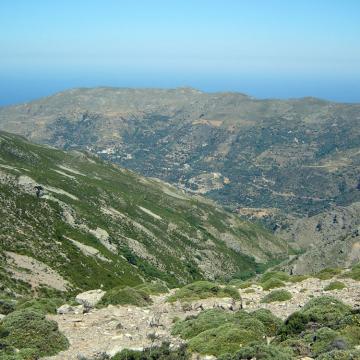GR4340016 - METERIZIA AGIOS DIKAIOS - TSOUNARA - VITSILIA LEFKON OREON
Map
Quality
The site is important for species characteristic of Mediterranean scrub. Species of concern include: Gypaetus barbatus. The site includes important bird areas such as Koutroulis mount, areas with endemic plant species (Dikaios mount and gorge), important caves (Agia Sofia) with stenoendemic invertebrates (the spider Pholcus creticus is found only in this cave), as well as gorges, running waters and rare in Crete or characteristic plant formations, such as the chestnut groves and the Arbutus unedo maquis respectively.Birds of prey and vultures as Aquila chrysaetos, Gyps fylvus and Gypaetus barbatus breed on Koutroulis mount, while Falco peregrinus, Pernis apivorus and Falco eleonorae live in or pass through the site. The endemic species Centaurea argentea and Centaurea redempta (IUCN 1993) are both protected by the Greek Law (Presidential Decree 67/81) are found on Dikaios mount and at Topolia area. Lathyrus neurolobus, Carex cretica and Campanula cretica (included in section 3.3. by its synonym Symphyandra cretica) are rare endemic species (IUCN, 1993), also protected by the Greek Law (Presidential Decree 67/81), and occur on Elos area. Many greek or cretan endemic plants (listed on 3.3.) are also found on mountain Dikaios (chasmophytic flora). Brassica cretica ssp. cretica is a chasmophyte found only in C. & S. Lebanon out of Greece.The site is also rich in cretan endemic snails (listed on section 3.3), many of them occurring only in westen Crete.Reptile species (listed on section 3.3.) protected by the Greek Law (Presidential Decree 67/81) and by the Bern convention (Annex II & III), as well as bats and the shrew Suncus etruscus, also legally protected and (Greek Law and Bern Convention) and listed on the Red Data Book of Greece, are constant residents, populating many of the smaller caves at Topolia. Finally, Rhinolophus ferrumequinum ssp. creticum, included in section 3.2.c. as Rhinolophus ferrum-equinum, is a subspecies endemic to Crete.The Elos and Pervolia areas are also ecologically important for the rare in southern Greece formations of sweet chestnut groves and woods (Castanea sativa). Arbutus unedo maquis, also rare in southern Greece and Crete, occur in the site.
Other characteristics
The site (West Crete), is a mountainous area, begining at Elos on the north, and includes in a south direction the mountains of Dikaiost (1181m), Tsounaras (1102 m) and Kalivaki (1010 m). The mountainous vegetation is mainly phryganic, dominated by the shrubby perennials sarcopoterium spinosum, Erica manipuliflora, Genista acanthoclada and Cistis spp. There are the characteristic of west Crete wet dense matorrals formations with Arbutus unedo and Erica arborea on non - limestone substrate. One of the rare chestnut (Castanea sativa) grove in Crete is situated near the Elos settlement. Hygrophyllous vegetations of Oriental Planes or Nerium oleander occupy the intermittently river of Thergi gorge. Olea europea groves occupy a little part of the south part of the site.
Documentation
1) CORINE Information System. European Environment Agency. CORINE, Biotopes, 1991.
2) Ekonomidou E., 1988. Entopismos kai meleti ton ygroviotopon kai allon simantikon gia tin ornithopanida viotopon tis Kritis (Location and study of wetlands and of other important for Avifauna biotopes of Crete). Final Report. Volume 1. Patras University - Ministry of Environment, Physical Planning and Public Works.T
3) Grimmet R.F.A. & Jones, (Compilers) 1989 : Important Bird Areas in Europe (ICBP), Technical publication no 9.
4) Heath, M. F. and Evans, M. I., eds. 2000. Important Bird Areas in Europe: Priority sites for conservation. 2: Southern Europe. Cambridge, UK: BirdLife International. BirdLife Conservation
Series No. 8, p. 791. 5) Hellenic Ornithological Society, 1994 : Simantikes Periohes gia ta Poulia tis Elladas
6) Karandeinos, M. (ed.). 1992. To Kokkino Vivlio ton apeiloumenon spondylozoon tis Elladas (The Red Data Book of threatened vertebrates of Greece). Hellen. Zool. Soc. & Hellen. Orn. Soc. p. 373.
7) Kypriotakis, Z. : unpublished data.
8) Legakis A. (Editor), 1995 : Apeiloumena, Prostateyomena kai Endimika eidi Zoon tis Eladas. Zoologiko Mouseio, Tm. Viologias, Pan. Athinon.
9) Martens, J. 1967 : Plecotus austriacus (Fischer) auf Kreta mit Bermerkumgen zu weiteren Arten (Mammalia, Chiroptera). Bonn.zool.Beitr. 18(3-4) : 253-362
10) Kypriotakis Z., Tzanoudakis D. & Tsiouris G. M. 1996. Vegetation map of Crete. Proceedings of the 6 th Botanical Conference, 5 - 11 April 1996, Paralimni - Cyprus 301 - 306, (in greek).
11) Turland N.J., Chilton L. & Press J.R., 1993 : Flora of the Cretan area. The Natural History Museum, London : HMSO.
12) Valakos, E. Unpublished data.
13) Vardinoyannis K., 1994. Biogeografia ton cherseon malakion sto notio nisiotiko aigaiako toxo (Biogeography of land snails in the south Aegean arc). Ph.D. Thesis. Univerity of Athens.
14) Wettstein O. 1953 : Herpetologia aegaea. Sber.oest. Akad. Wiss. math.- naturw. Kl.Ab. I 162(9-10) : 651-833.
15) Georghiou K. 1995. Checklist of Endemic, Rare and Threatened Plants of Greece. Draft. University of Athens. (3.3, 3.4, 4.2)
16) Sowig P. 1985. Beitrage zur Kenntnis der Verbreitung und Okologie der Amphibien und Reptilien Kretas. Slamandra, 21 (4): 252 - 262.
17) Trichas A. 1996. Oikologia kai Biogeografia ton edafikon Koleopteron sto Notio Aigaio, me emfasi sti sunthesi, epoxiaki kai biotopiki diaforopiisi kai zoogeografia ton oikogeneion Carabidae kai Tenebridae. Didaktoriki Diatribi. Pan/mio Kritis.
18) Willwmse, F. 1984. Catalogue of the Orthoptera of Greece. Hell. Zool. Soc. P. 275.
Reference: Natura 2000 data form, database release 7 Feb 2014



